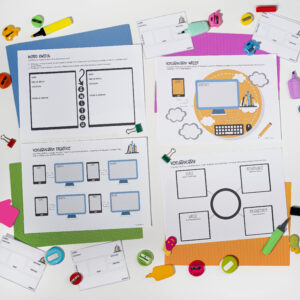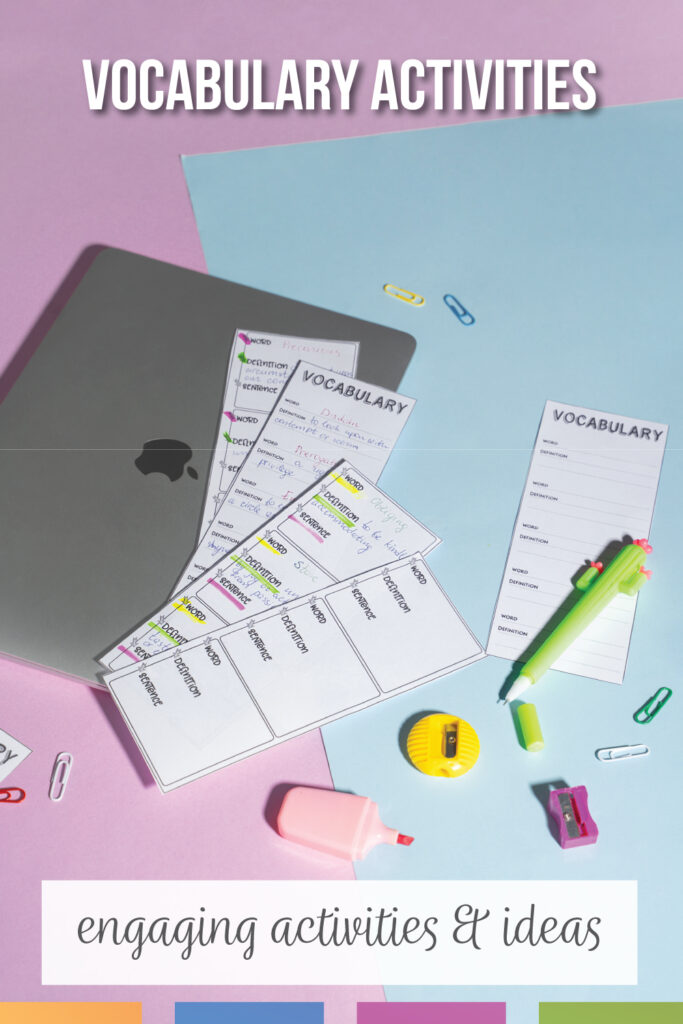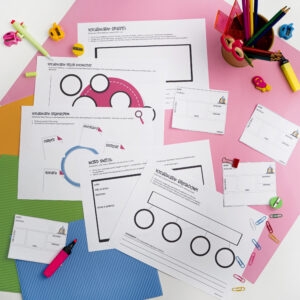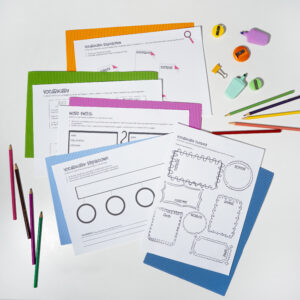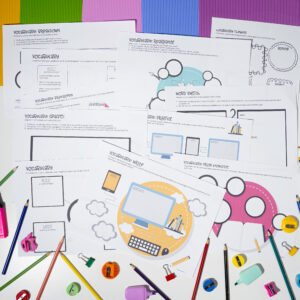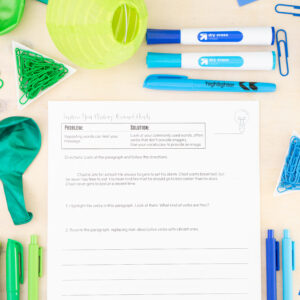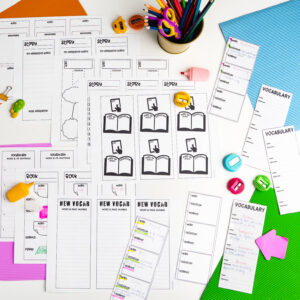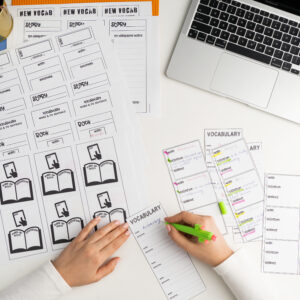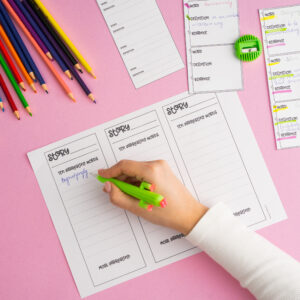Meaningful vocabulary activities can benefit students for the rest of their lives.
The language standards are clear: We must move students beyond simple memorization of a word and its term. Students should consider the word’s connotation and denotation, be able to use the words in different formats, and examine how language changes over time.
No matter how I acquire a vocabulary list, students and I walk through a four steps with vocabulary. Whenever we are deep into learning, busy manipulating language and rearranging words, I find myself relying on these four steps. They are simple steps, and you’ll be able to use them across grade levels.
I will NOT complete these four steps with every single word. When students need modeling or help with one word, however, we will run through these steps.
The beautiful part? You can too—in no particular order and with as many parts of the process as you need.
Why is it important to engage students in activities that promote meaningful vocabulary acquisition?
Engaging students in activities that promote meaningful vocabulary acquisition is important because it helps them understand and use vocabulary in meaningful contexts. This leads to better retention and application of vocabulary knowledge, improving their overall language skills and communication abilities.
The process consists of building on prior knowledge, rearranging the word, finding a picture, and brainstorming. Below, I’ll use the word “precarious” to model.
Build on prior knowledge.
To begin, I share the educational concept of “prior knowledge” with students. Doing so builds cognitive awareness. When I tell students that research supports our meaningful vocabulary activities, I increase buy-in.
With the word “precarious,” I might say something like:
Look at “precarious.” The definition is “dependent on circumstances beyond one’s control.”
Students might need help understanding “dependent” or “circumstances” (for example), and I’ll model how to understand the definition. Sometimes, we write out the definition and then define the words contained in the definition.
Comprehension with vocab.
Sometimes to build on prior knowledge, we run through word meanings related to a current word until learners supply their own words we can relate to the new vocabulary words.
Then, we continue walking through the process of building prior knowledge and making sense of this new piece of information (the definition) by drawing connections.
Connections.
So what in your life is precarious? (Help students activate prior knowledge.) Ideas might include: weather, money, living arrangements, certain times in history (war).
Continue working with these ideas with which students are already familiar, showing students how “precarious” connects to their lives:
- As teenagers, our students often have little control over where they live or their financial situations. Students probably have been in a precarious situation.
- Also, sans a futuristic gadget, humans cannot control the weather. As much as we wish it would not storm during a family picnic, it might.
- War. Unfortunately, citizens have little control over their country going to war. The draft is often seen as a precarious situation as well.
Through a personalized approach, a human approach, and a historical approach, you have helped students build constructions with their prior knowledge as the basics.
Different ways work for different classes and age groups. Keep building connections with related words.
Rearrange the vocabulary word.
Meaningful vocabulary activities should allow students to play with the vocabulary word, using it in a sentence or context. Sure, students should use the original word, but to advance student understanding, use the word in varying ways—rearrange it. Not only will students understand their word, but they will also expand their vocabulary in general. Many standards require students to use the dictionary and to understand the word in different forms.
When I work to manipulate the word with students, I’ll pull up the dictionary for the class.
Under “precarious,” we’ll see precariously (adverb) and precariousness (noun). At this opportunity, I will talk about those different forms and remind students of the definitions. An adverb modifies a verb, adjective, or another adverb. This adverb ends in ‘-ly.’ A noun is a person, place, or thing. This noun ends in ‘ness.’
Typically, I let students work with a partner to create sentences for these two words. I encourage goofiness (but prohibit cruelty) and require actual context. We avoid sentences that do not show context: Precariousness is nice. Instead, the rearranged vocabulary word should showcase understanding of the term.
- The puppy precariously stuck his front legs over the baby gate, but he could not rotate his back legs.
- The precariousness of the looming legal trial made the family reassess their situation.
As I work with vocabulary lessons, I learn that modeling helps students learn what works for them. We rearrange the words together, and then students do so independently. Modeling is an important component of meaningful vocabulary activities.
Find a picture.
When I think of other areas of my classes, like creative writing, I consider how I can borrow teaching concepts and apply them to language lessons. Pictures, images, and fun videos immediately come to mind.
I will use pictures to connect to vocabulary words in several ways:
- In advance, I’ll find pictures that seem “precarious.”
- During the activity, I’ll ask students to draw a picture that relates to “precarious.”
- As we work through the lesson, I’ll ask students to find a picture of a “precarious” situation. Students typically do a basic image search.
We will also work on connotation and denotation with the thesaurus. Pull up the thesaurus for students. Type in “precarious.” Which word best articulates the action in this picture? Consider the word’s connotation.
Finally, I will print some of the students’ pictures or sketches and add them to our word wall. With our word walls, we build a visual level of understanding with our vocabulary words.
Sketches.
Another spin on pictures with a new word might work with sketches. Take a piece of paper and fold it twice for four parts. In small groups, have members take turns adding to the four pieces. Learners can sketch out the correct definition, synonyms, antonyms, a social media post by the word, or a cartoon are some of the options for each corner of the page. Be sure to display finished products.
The best way (with found pictures or sketches) is to make meaningful vocabulary lessons fun. Sure, sketching out an Instagram post written by a vocabulary word is goofy, but it is also a terrific way to remember a vocabulary word’s meaning.
Brainstorm.
As a final component in working with vocabulary words, I ask students to imagine or predict situations in which they will use the vocabulary word. I’ve found that brainstorming uses of a word connects to our first step of building on prior knowledge.
So I’ll ask: In what situations would you use the word “precarious”? I often present fun situations that require critical thinking: How would you use the word. . .
- In a fantasy story?
- When purchasing something?
- While experiencing a strong emotion?
Then, write! Most of my graphic organizers address the “writing” component of this process. Most commonly, I ask students to use some of their words in whatever writing assignment we are currently working on. You can also easily turn these vocabulary word studies into a creative writing quick-write. For instance, ask students to use the words in a fantasy story! Ask them to draft a mock email to a famous person as a historical fiction document. Adding vocabulary to creative writing means the sky is the limit.
Meaningful vocabulary activities.
The process is flexible which means that activities can vary.
First, bookmarks are a great way to acquire words and review them later. Have students create their own personalized vocabulary bookmarks by writing down new words they come across in their reading and adding a brief definition or sentence using the word. Encourage them to use colorful designs and illustrations to make their bookmarks visually appealing.
Another engaging activity is creating vocabulary matching games. Type words and definitions in large font. Print, cut, and separate. Have classes match the words to their definitions.
Finally, collaborative storytelling is another effective way to practice words. One method is to grab a large piece of paper and start a story that includes a word. Pass the paper with individuals adding sentences to create a goofy story. Another option is to practice verbal skills and tell a story orally, one participant at a time.
The more you engage with words, the easier meaningful vocabulary activities will unfold in your classes.
ELA vocabulary lessons: a final word.
Vocabulary instruction varies dependent upon everyone’s needs. However, that process is a rough outline, a template for me to work with classes.
When I model these works with this vocabulary process, “precarious” is a favorite word that students can understand and still learn. “Cordial” works well too. Any word that has multiple forms works well.
I hope these talking points help you as you work on vocabulary with your students, and I hope you can weave some of these examples into your own meaningful vocabulary activities.
The more I work through language standards for middle school and high school English students, the more benefits I see to overlapping and connecting all components of language standards—grammar and vocabulary and every connecting piece.


